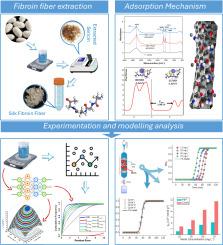揭示蚕丝纤维去除铅(II)和铬(VI)的生物吸附性能:机器学习和 DFT 分析
IF 6.3
2区 工程技术
Q1 ENGINEERING, CHEMICAL
引用次数: 0
摘要
本研究调查了丝纤维(SFF)作为一种高效生物吸附剂在去除水中铅(Pb(II))和铬(Cr(VI))方面的应用。采用人工神经网络(ANN)和多项式回归模型(PRMs)对批量吸附试验进行预测和评估,并使用各种统计量评估其准确性。在不同的操作条件下,优化后的 ANN 预测在较高的 pH 值(10.59)下,铅(II)的最大吸附容量(qmax)为 ~39.69 μmoles g-1。相比之下,在底物浓度较高和接触时间较长的情况下,铬(VI)的 qmax 较高(140.38 μmoles g-1)。统计分析显示,高阶 PRM 的准确度有所提高,平均平方误差 (MSE) 下降到 92.05%。而 PRM 在更高的误差阈值下表现出了具有竞争力的准确性。接触时间是影响铅(II)吸附的最关键因素(占 45.7%),其次是温度和 pH 值。六价铬的吸附也呈现出类似的趋势。突破曲线显示,进水浓度与突破时间之间存在反比关系。进水浓度越高,吸附位点的饱和速度越快,因此所有模型的突破时间都更快。同样,由于相同的效应,流速越高,突破速度越快。密度泛函理论计算表明,与铅(II)相比,SFF 对六价铬(Cr(VI))具有很强的亲和力,这涉及范德华和配位共价键类型机制的结合,通过羰基和胺基团优先吸附。值得注意的是,用乙二胺四乙酸(EDTA)再生后,金属吸附能力仍然保持不变,这表明 SFF 床可成功重复使用,证明 SFF 具有作为可重复使用的强效生物吸附剂进行净化的潜力。本文章由计算机程序翻译,如有差异,请以英文原文为准。

Unveiling the biosorption performance of silk fibroin fiber for Pb(II) and Cr(VI) removal: Machine learning and DFT analysis
This study investigates the application of silk fibroin fiber (SFF) as an efficient biosorbent for lead (Pb(II)) and chromium (Cr(VI)) removal from water. Artificial neural network (ANN) and polynomial regression models (PRMs) were employed for prediction and assessment of batch adsorption tests, with their accuracy evaluated using various statistical measures. Under the varying operating conditions, optimized ANN predicted the maximum adsorption capacity (qmax) of ~39.69 μmoles g−1 for Pb(II) at higher pH: 10.59. In contrast, Cr(VI) exhibited a higher qmax (140.38 μmoles g−1) at elevated substrate concentrations and extended contact times. Statistical analysis revealed that higher-order PRMs achieved improved accuracy, with the mean squared error (MSE) decreasing to 92.05 %. While PRMs demonstrated competitive accuracy at higher error thresholds. Contact time emerged as the most crucial factor for Pb(II) adsorption (contributing 45.7 %), followed by temperature and pH. Cr(VI) adsorption exhibited a comparable trend. Breakthrough curves revealed an inverse relationship between influent concentration and breakthrough time. Higher influent concentrations led to faster saturation of adsorption sites, resulting in quicker breakthrough times for all models. Similarly, higher flow rates resulted in faster breakthrough due to the same effect. Density functional theory calculations suggested SFF's strong affinity for Cr(VI) compared to Pb(II) which involves a combination of Van der Waals and coordinate covalent bonds type mechanism, with preferential adsorption through carbonyl and amine groups. Notably, the metal uptake capacity remained consistent after regeneration with EDTA, signifying the successful reusability of the SFF bed, demonstrating SFF's potential as a robust reusable biosorbent for decontamination.
求助全文
通过发布文献求助,成功后即可免费获取论文全文。
去求助
来源期刊

Journal of water process engineering
Biochemistry, Genetics and Molecular Biology-Biotechnology
CiteScore
10.70
自引率
8.60%
发文量
846
审稿时长
24 days
期刊介绍:
The Journal of Water Process Engineering aims to publish refereed, high-quality research papers with significant novelty and impact in all areas of the engineering of water and wastewater processing . Papers on advanced and novel treatment processes and technologies are particularly welcome. The Journal considers papers in areas such as nanotechnology and biotechnology applications in water, novel oxidation and separation processes, membrane processes (except those for desalination) , catalytic processes for the removal of water contaminants, sustainable processes, water reuse and recycling, water use and wastewater minimization, integrated/hybrid technology, process modeling of water treatment and novel treatment processes. Submissions on the subject of adsorbents, including standard measurements of adsorption kinetics and equilibrium will only be considered if there is a genuine case for novelty and contribution, for example highly novel, sustainable adsorbents and their use: papers on activated carbon-type materials derived from natural matter, or surfactant-modified clays and related minerals, would not fulfil this criterion. The Journal particularly welcomes contributions involving environmentally, economically and socially sustainable technology for water treatment, including those which are energy-efficient, with minimal or no chemical consumption, and capable of water recycling and reuse that minimizes the direct disposal of wastewater to the aquatic environment. Papers that describe novel ideas for solving issues related to water quality and availability are also welcome, as are those that show the transfer of techniques from other disciplines. The Journal will consider papers dealing with processes for various water matrices including drinking water (except desalination), domestic, urban and industrial wastewaters, in addition to their residues. It is expected that the journal will be of particular relevance to chemical and process engineers working in the field. The Journal welcomes Full Text papers, Short Communications, State-of-the-Art Reviews and Letters to Editors and Case Studies
 求助内容:
求助内容: 应助结果提醒方式:
应助结果提醒方式:


